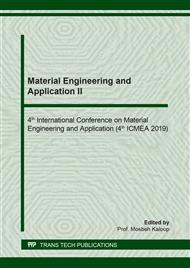p.59
p.64
p.70
p.76
p.82
p.87
p.94
p.99
p.103
Electrospinning/Spray: The Interaction between Graphene Nanosheets and Different Nanofibers
Abstract:
The electrospun nanofiber/graphene composites is a promising candidate in the field of flexible strain sensors due to the synergic effect of graphene and the nanofibers. It is an effective way to synthesize a uniform graphene-embedded film by simultaneously electrospinning nanofibers and electrospraying graphene nanosheets. In this paper, we prepare two specimens of different materials to study the interaction between graphene nanosheets and nanofibers under the same process parameters, such as thermoplastic urethane (TPU), polyacrylonitrile (PAN). Then, morphology and mechanical properties are used to characterize the interaction. The mechanical test was conducted by the tensile tester, and the surface morphology of electrospun nanofibrous films was observed through a microscope. By comparing these results, the properties of the graphene nanosheets embedded to different nanofibers are explored. This study provides a good way to select an appropriate nanofiber matrix for the application in flexible strain sensors.
Info:
Periodical:
Pages:
82-86
Citation:
Online since:
May 2020
Authors:
Keywords:
Price:
Сopyright:
© 2020 Trans Tech Publications Ltd. All Rights Reserved
Share:
Citation:


